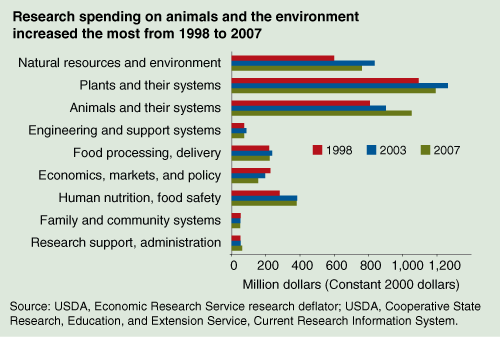The Evolving Public Agricultural Research Portfolio
- by David Schimmelpfennig and Paul Heisey
- 3/1/2009
The Federal-State partnership that constitutes public research and development (R&D) contributes to agricultural productivity through the introduction of new technologies that improve efficiency or enhance the quality of products. Over the past few decades, advances in the biological sciences, as well as legislation that strengthened intellectual property protection, have provided new tools for agricultural research and enhanced private incentives for technology development. The growth in private R&D spending (which surpassed public spending in the early 1980s) has freed publicly funded agricultural research to focus on basic research and topics with broad public benefits—topics not pursued by private companies focused on developing commercial products.
At the same time, the sources of funding for public agricultural research have been changing (see “Sources of Public Agricultural R&D Changing,” Amber Waves, June 2007), as have the programs that channel funds to the agricultural research community. One result of all these developments has been a gradual shift in the emphasis of public agricultural research over the years.
Within the last decade, funding for public agricultural research, conducted by scientists at USDA’s Agricultural Research Service, State Agricultural Experiment Stations, and related research institutions, has increased in real (inflation-adjusted) terms by slightly over 10 percent. Research spending on both plants and animals—which together accounted for 57 percent of total public research spending in 2007—increased faster than average. Animal research jumped 30 percent between 1998 and 2007, reflecting increased research on animal diseases, animal physiological processes, and animal genomes. The largest dollar increase in animal-related research was for animal diseases, partially in response to threats such as bovine spongiform encephalopathy (BSE), foot-and-mouth disease, and avian influenza. The largest percentage amount was for animal genomics, an area in which the public sector has played a prominent leadership role.
Funding also increased substantially for natural resources and the environment, which accounts for roughly 20 percent of the public agricultural research pie. This broad research area includes soil and water conservation and management, forest and range management, pollution, weather, and impacts of production on biological diversity. Research on these issues often has particularly strong public benefits that accrue over the long term. As a result, private firms have little incentive to pursue these topics.
The other agricultural research areas receive far less support. Only research programs on human nutrition and food safety showed pronounced growth, with spending (in constant dollars) growing 35 percent between 1998 and 2007. Like environmental research, research on human nutrition and food safety has substantial public benefits. Funding for the other smaller research areas has remained relatively stable over the past 10 years.
This article is drawn from:
- Agricultural Research and Productivity. (n.d.). U.S. Department of Agriculture, Economic Research Service.
You may also like:
- Sources of Public Agricultural R&D Changing. (2007). USDA, Economic Research Service. in Amber Waves, Vol. 5, No. 3..


